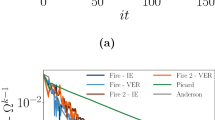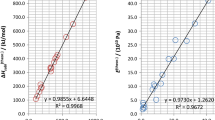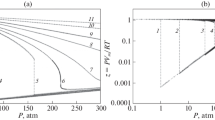Abstract
The notion of fluids immiscibility is examined from the field observations (i.e. rock samples or measurements in drill holes) and experimental point of view, as well as from usual thermodynamics and theoretical hard-soft and acid–base and density functional theory concepts. Basically, fluids immiscibility relates to a difference in chemical potentials between the elements in presence, i.e. some differences in the first derivative of their free energy. The latter usually plots as a quartic curve with upward concave curvature. However, it can develop a local maximum, inducing immiscibility. The theoretical chemistry concepts consider in addition to chemical potential, the second derivatives of the energy, as hardness and electrophilicity, or polarizability and magnetizability. Those are due to external field components, electric or magnetic, whereas the two former derivatives depend directly on the quantitative changes in the electronic cloud. Those descriptors give insights to reactions evolution during the reaction path. Their introduction in the definition of fluids immiscibility is examined, documenting chemical reactions and path reflecting an open system. Mapping the values of molecule polarizability shows a linear trend from silica to fayalite and leucite, i.e. magnesian and alkali-alumino silicates. A local positive anomaly in polarizability, due to the near-by influence of phosphorous controls the extent of the immiscibility area. The technique could easily be applied in other fields to control hydrophilicity or hydrophobicity.










Similar content being viewed by others
References
Aharonov Y, Bohm D (1959) Significance of electromagnetic potentials in quantum theory. Phys Rev 115:485–491
Ando T, Fowler AB, Stern F (1982) Electronic properties of two-dimensional systems. Rev Mod Phys 54:437–672
Ayers PW (2007) The physical basis of the hard/soft acid/base principle. Faraday Discuss 135:161–190
Badanina EV, Veskler I, Thomas R, Syrito LF, Trumbull R (2004) Magmatic evolution of Li–F, rare-metal granites: a case study of melt inclusions in the Khangilay complex, Eastern Transbaikalia (Russia). Chem Geol 210:113–133
Balhaus C, Fonseca ROC, Münker C, Kirchenbaur M, Zirner A (2015) Spheroidal textures in igneous rocks—textural consequences of H2O saturation in basaltic melts. Geochim Cosmochim Acta 167:241–252
Ballouard C, Elburg MA, Tappe S, Reinke C, Ueckermann H, Doggart S (2020) Magmatic-hydrothermal evolution of rare metal pegmatites from the Mesoproterozoic Orange River pegmatite belt (Namaqualand, South Africa). Ore Geol Rev 116:103252
Becke AD (1993) A new mixing of Hartree–Fock and local density-functional theories. J Phys Chem 98:1372–1377
Béguin P, Aubert JP (1994) The biological degradation of cellulose. FEMS Microbiol Rev 13:25–58
Bogaerts M, Schmidt MW (2006) Experiments on silicate melt immiscibility in the system Fe2SiO4–KAlSi3O8–SiO2–CaO–MgO–TiO2–P2O5 and implications for natural magmas. Contrib Miner Petrol 152:257–274
Cahn JW, Hilliard JE (1958) Free energy of a nonuniform system. I. Interfacial free energy. J Chem Phys 28:258–267
Carstens H (1982) Spherulitic crystallization in lamprophyric magmas and the origin of ocelli. Nature 297:493–494
Charles RJ (1969) Origin of immiscibility in silicate solutions. Phys Chem Glasses 10:169–178
Chattaraj PK, Giri S (2009) Electrophilicity index within a conceptual DFT framework. Annu Rep Prog Chem C 105:13–39
Chattaraj PK, Giri S, Duley S (2012) Update 2 of: electrophilicity index. Chem Rev 111:PR43–PR75
Chattaraj PK, Lee H, Parr RG (1991) HSAB principles. J Am Chem Soc 113:1855–1856
Chermak JA, Rimstidt JD (1989) Estimating the thermodynamic properties of silicate minerals at high temperatures from the sum of polyhedral contributions. Am Miner 75:1376–1380
Chermette H (1999) Chemical reactivity indexes in density functional theory. J Comput Chem 20:129–154
Currie KL (1972) A criterion for predicting liquid immiscibility in silicate melts. Nat Phys Sci 240:66–67
Diaz-Alvaro J, Rodriguez N, Rodriguez C, Fernandez C, Constanzo I (2017) Petrology and geochemistry of the orbicular granitoid of Caldera, Northern Chile. Models and hypotheses on the formation of radial orbicular textures. Lithos 284–285:327–346
Duley S, Vigneresse JL, Chattaraj PK (2012) Fitness landscapes in natural rocks system evolution: a conceptual DFT treatment. J Chem Sci 124:29–34
Elliston JN (1984) Orbicules: an indication of the crystallization of hydrosilicates. Earth Sci Rev 20:265–344
Emery X (2005) Simple and ordinary multigaussian kriging for estimating recoverable reserves. Math Geol 37:295–319
Gaussian 03 W, revision B.03 (2003) Gaussian, Inc., Pittsburgh
Geerlings P, De Proft F, Langenaeker W (2003) Conceptual density functional theory. Chem Rev 103:1793–1873
Gerbaud V, Rodriguez-Donis I, Laszlo H, Péter L, Ferenc D, Xinqiang Y (2018) Review of extractive distillation. process design, operation optimization and control. Chem Eng Res Des 141:1–43
Ghanty TK, Ghosh SK (1993) Correlation between hardness, polarizability, and size of atoms, molecules, and clusters. J Phys Chem 97:4951–4953
Ghanty TK, Gosh SK (1996) A density functional approach to hardness, polarizability, and valency of molecules in chemical reactions. J Phys Chem 100:12295–12298
Ghiorso MS, Carmichael ISE, Rivers ML, Sack O (1983) The Gibbs free energy of mixing of natural silicate liquids: an expanded regular solution approximation for the calculation of magmatic intensive variables. Contrib Miner Petrol 84:107–145
Gibbs JW (1873) A method of geometrical representation of the thermodynamic properties of substances by means of surfaces. Trans Conn Acad Arts Sci 2:382–404
Holness MB, Tegner C, Namur O, Pilbeam L (2015) The earliest history of the Skaergaard magma chamber: a textural and geochemical study of the Cambridge drill core. J Petrol 56:1199–1227
Holness MB, Tegner C, Nielsen TFD, Charlier B (2017) The thickness of the mushy layer on the floor of the Skaergaard magma chamber at apatite saturation. J Petrol 58:909–932
Hudon P, Baker DR (2002) The nature of phase separation in binary oxide melts and glasses: I. Silicate systems. J Non-Cryst Solids 303:299–345
Hunter RH, Sparks RSJ (1987) The differentiation of the Skaergaard Intrusion. Contrib Miner Petrol 95:451–461
Iveson AA, Webster JD, Rowe MC, Neill OW (2019) Fluid-melt trace-element partitioning behaviour between evolved melts and aqueous fluids: experimental constraints on the magmatic-hydrothermal conditions. Chem Geol 516:18–41
Jakobsen JK, Veksler I, Tegner C, Brooks CK (2005) Immiscible iron- and silica-rich melt in basalt petrogenesis documented in the Skaergaard intrusion. Geology 33:885–888
Jana G, Pal R, Sural S, Chattaraj PK (2020) Quantitative structure–toxicity relationship models based on hydrophobicity and electrophilicity. In: Roy K (ed) Ecotoxicological QSARs. Methods in pharmacology and toxicology. Humana, Totowa, pp 661–679
Kamenetsky VS, Kamenetsky MB (2010) Magmatic fluids immiscible with silicate melts: examples from inclusions in phenocrysts and glasses, and implications for magma evolution and metal transport. Geofluids 10:293–311
Kohn W, Sham L (1965) Self-consistent equations including exchange and correlation effects. Phys Rev 140:A1133–A1138
Landau I, Lifchitz R (1967) Physique Théorique. Théorie des Champs. Mir, Moscow
Lasaga AC, Cygan RT (1982) Electronic and ionic polarizabilities of silicate minerals. Am Miner 67:328–334
Law JY (2014) Definitions for hydrophilicity, hydrophobicity, and superhydrophobicity: getting the basics right. J Phys Chem Lett 5:686–688
Levin EM, Block S (1957) Structural interpretation of immiscibility in oxide systems: I. Analysis and calculation of immiscibility. J Am Ceram Soc 40:95–106
Ma H, Hu Y, Fang T (1999) TWOLIQ.FOR: a FORTRAN77 program for simulating immiscibility in silicate liquids. Comput Geosci 5:151–159
Maaløe S (1976) The zoned plagioclase of the Skaergaard Intrusion, East Greenland. J Petrol 17:398–419
Maaløe S (1978) The origin of rhythmic layering. Miner Mag 42:337–345
Mardirossian N, Head-Gordon M (2017) Thirty years of density functional theory in computational chemistry: an overview and extensive assessment of 200 density functionals. Mol Phys 115:2315–2372
McBirney AR (1996) The Skaergaard intrusion. Dev Petrol 16:147–180
McBirney AR, Naslund HR (1990) The differentiation of the Skaergaard intrusion. A discussion of Hunter and Sparks (Contrib Mineral Petrol 95:451–461). Contrib Miner Petrol 104:235–247
Miranda-Quintana RA (2017) Thermodynamic electrophilicity. J Chem Phys 146:214113
Miranda-Quintana RA, Chattaraj PK, Ayers PW (2017) Finite temperature grand canonical ensemble study of the minimum electrophilicity principle. J Chem Phys 147:124103
Mortier WJ, Ghosh SK, Shankar S (1986) Electronegativity-equalization method for the calculation of atomic charges in molecules. J Am Chem Soc 108:4315–4320
Mysen BO (1988) Structure and properties of silicate melts. Elsevier, New York
Nielsen TFD (2004) The shape and volume of the Skaergaard Intrusion, Greenland: implications for mass balance and bulk composition. J Petrol 46:507–530
Novick-Cohen A (2008) The Cahn–Hilliard equation. In: Dafermos CM, Feireisl E (eds) Handbook of differential equations. Vol. 4. Evolutionary equations. Elsevier, New York, pp 201–228
Pal R, Jana G, Sural P, Chattaraj PK (2018) Hydrophobicity versus electrophilicity: a new protocol toward quantitative structure–toxicity relationship. Chem Biol Drug Des 93:1083–1095
Pan S, Sola M, Chattaraj PK (2013) On the validity of the maximum hardness principle and the minimum electrophilicity principle during chemical reactions. J Phys Chem A 117:1843–1852
Parr RG, Bartolotti LJ (1982) On the geometric mean principle for electronegativity equalization. J Am Chem Soc 104:3801–3803
Parr RG, Chattaraj PK (1991) Principle of maximum hardness. J Am Chem Soc 113:1854
Parr RG, Pearson RG (1983) Absolute hardness: companion parameter to absolute electronegativity. J Am Chem Soc 105:7512–7516
Parr RG, Yang W (1984) Density functional approach to the frontier-electron theory of chemical reactivity. J Am Chem Soc 106:4049–4050
Parr RG, von Szentpály L, Liu SB (1999) Electrophilicity index. J Am Chem Soc 121:1922–1924
Pauling L (1932) The nature of the chemical bonds. IV. The energy of single bonds and the relative electronegativity of atoms. J Am Chem Soc 54:3570–3582
Pearson RG (1963) Hard and soft acids and bases. J Am Chem Soc 85:3533–3539
Pearson RG (1988) Absolute electronegativity and hardness: application to inorganic chemistry. Inorg Chem 27:734–740
Pearson RG (1997) Chemical hardness. Wiley, New York, p 210
Roedder E (1951) Low temperature liquid immiscibility in the system K2O–FeO–Al2O3–SiO2. Am Miner 36:282–286
Roedder E (1978) Silicate liquid immiscibility in magmas and in the system K2O–FeO–Al2O3–SiO2: an example of serendipity. Geochim Cosmochim Acta 42:1597–1617
Roedder E (1984) Fluid inclusions. Rev Mineral 12:646
Roedder E (1992) Fluid inclusion evidence for immiscibility in magmatic differentiation. Geochim Cosmochim Acta 56:5–20
Sanderson RT (1951) An interpretation of bond lengths and a classification of bonds. Science 1951(114):670–672
Sanderson RT (1976) Chemical bonds and bond energy. Academic, New York
Saxena S (1973) Thermodynamics of rock-forming crystalline solutions. Springer, Heidelberg, p 188
Shelby JE (2005) Introduction to glass science and technology. Royal Society of Chemistry, London
Simon MO, Li CJ (2012) Green chemistry oriented synthesis in water. Chem Soc Rev 41:1415–1427
Stephens PJ, Devlin FJ, Chabalowski CF, Frisch MJ (1994) Ab initio calculation of vibrational absorption and circular dichroism spectra using density functional force fields. J Phys Chem 98:11623–11627
Tanwar A, Pal S, Roy DR, Chattaraj PK (2006) Minimum magnetizability principle. J Chem Phys 125:056101
Taylor P, Campbell AB, Owen DK (1982) Liquid immiscibility in the systems X2O–MO–B2O3–SiO2(X = Na, K; M = Mg, Ca, Ba) and Na2O–MgO–BaO–B2O3–SiO2. J Am Ceram Soc 66:347–351
Thomas R, Webster JD, Rhede D, Seifert W, Rickers K, Förster H, Heinrich W, Davidson P (2006) The transition from peraluminous to peralkaline granitic melts: evidence from melt inclusions and accessory minerals. Lithos 91:137–149
Thompson AB, Aerts M, Hack AC (2007) Liquid immiscibility in silicate melts and related systems. Rev Mineral Geochem 65:99–127
Thy P, Lesher CE, Tegner C (2009) The Skaergaard liquid line of descent revisited. Contrib Miner Petrol 157:735–747
Veksler IV, Teptelev MP (1990) Conditions for crystallization and concentration of perovskite-type minerals in alkaline magmas. Lithos 26:177–189
Veskler IV, Petibon C, Jenner GA, Dorfmann AM, Dingwell DB (1998) Trace element partitioning in immiscible silicate–carbonate liquid systems: an initial experimental study using a centrifuge autoclave. J Petrol 39:2095–2104
Vigneresse JL, Duley S, Chattaraj PK (2011) Describing the chemical character of a magma. Chem Geol 287:102–113
Vigneresse JL (2012) Chemical reactivity parameters (HSAB) applied to magma evolution and ore formation. Lithos 153:154–164
Vigneresse JL (2018) Variations in chemical descriptors during reactions. Chem Phys Lett 706:577–585
Vigneresse JL, Truche L (2018) Chemical descriptors for describing physico-chemical properties with applications to geosciences. J Mol Model 24:231. https://doi.org/10.1007/s00894-018-3770-0
Vigneresse JL, Truche L, Richard A (2019) How do metals escape from magmas to form porphyry-type ore deposits? Ore Geol Rev 105:310–336
Wager LR, Deer WA (1939) Geological investigations in East Greenland. Part III. The petrology of the Skaergaard Intrusion, Kangerdlugssuaq. Meddelselser om Grønland 105:346
Wright S (1932) The roles of mutation, inbreeding, crossbreeding and selection in evolution. In: Proceedings of the sixth annual congress in genetics, vol 1, pp 356–366
Yildiz D, Bozkaya U (2016) Assessment of the extended Koopmans' theorem for the chemical reactivity: Accurate computations of chemical potentials, chemical hardnesses, and electrophilicity indices. J Comput Chem 37:345–353
Ylimaz O (2001) Seismic data analysis. Society of Exploration Geophysicists, Tulsa
Zhao Y, Truhlar DG (2004) Hybrid meta density functional theory methods for thermochemistry, thermochemical kinetics, and noncovalent interactions: the MPW1B95 and MPWB1K models and comparative assessments for hydrogen bonding and van der Waals interactions. J Phys Chem A 108:6908
Acknowledgements
This paper came out from discussions about ore generation in a magmatic context, with colleagues, Antonin Richard and Laurent Truche, both at GeoRessources, Nancy. Interestingly, the lab, former CREGU, has been founded by Bernard Poty, partly for studying fluid inclusions, when he came back from US and invented the Chaixmeca stage in 1972. Later on, I was introduced to theoretical chemistry by Pratim K Chattaraj at IIT Kharagpur, India. He encouraged me to continue in this way. Fruitful discussions about the Skaergaard, initially with late Alexander McBirney, and later with Marian Holness and Troels Nielsen guided my reflections. Three anonymous reviewers are acknowledged for their valuable comments about DFT and cDFT.
Author information
Authors and Affiliations
Corresponding author
Ethics declarations
Conflict of interest
The author declare that no conflict of interest.
Availability of data and material
The whole data set is totally available on request.
Additional information
Publisher's Note
Springer Nature remains neutral with regard to jurisdictional claims in published maps and institutional affiliations.
Rights and permissions
About this article
Cite this article
Vigneresse, JL. Revisiting immiscibility through DFT chemical descriptors. Theor Chem Acc 139, 142 (2020). https://doi.org/10.1007/s00214-020-02652-6
Received:
Accepted:
Published:
DOI: https://doi.org/10.1007/s00214-020-02652-6




